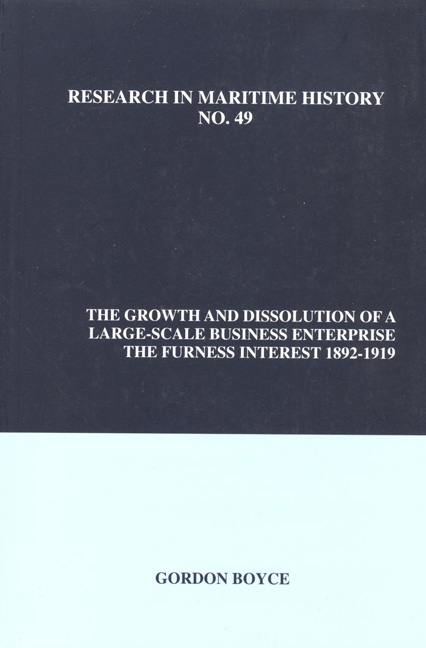Book contents
- Frontmatter
- Table of Contents
- About the Author
- Acknowledgements
- Figures and Tables
- Introduction
- Chapter 1 Furness' Shipping Services: Growth by Organic Means in the 1880s
- Chapter 2 The 1890s: Furness Withy's Expansion by Acquisition and Promotion
- Chapter 3 Diversification into the Industrial Sector, 1895-1901
- Chapter 4 Trouble on the Transatlantic Route: The Formation of the IMM and Furness' Response
- Chapter 5 The Growth of Shipping Services, 1902-1909
- Chapter 6 Industrial Operations and Performance, 1900-1914
- Chapter 7 The Growth of the Shipping Interests, 1910-1919
- Chapter 8 Structure
- Chapter 9 Finance
- Chapter 10 Holding Company Investment Activities and Intermediary Operations
- Chapter 11 Personnel
- Chapter 12 Furness
- Chapter 13 Dissolution
- Appendix 1 Development of the Combined Fleet, 1900-1919
- Appendix 2a Patterns of Ownership: The Furness Group, 1919
- Appendix 2b Reorganization of Branch Offices and Superintending Departments, 1911-1912
- Appendix 3a Fluctuations in Freights, Profits, Tonnage Afloat and Merchant Shipping Output
- Appendix 3b Output of Merchant Tonnage (Excluding Warships), 1892-1913
- Appendix 3c Fluctuations in the Price of a 7500-ton Cargo Steamer, 1898-1913
- Appendix 4 Development of the Furness Group: Principal Promotions, Acquisitions and Divestments, 1880-1919
- Appendix 5 Northern Allies and Maritime Associates
- Appendix 6 Contemporary Accounting Law and Conventions, 1845-1914
- Appendix 7 Lord Furness' Movements, 1899-1912
- Bibliography
Introduction
- Frontmatter
- Table of Contents
- About the Author
- Acknowledgements
- Figures and Tables
- Introduction
- Chapter 1 Furness' Shipping Services: Growth by Organic Means in the 1880s
- Chapter 2 The 1890s: Furness Withy's Expansion by Acquisition and Promotion
- Chapter 3 Diversification into the Industrial Sector, 1895-1901
- Chapter 4 Trouble on the Transatlantic Route: The Formation of the IMM and Furness' Response
- Chapter 5 The Growth of Shipping Services, 1902-1909
- Chapter 6 Industrial Operations and Performance, 1900-1914
- Chapter 7 The Growth of the Shipping Interests, 1910-1919
- Chapter 8 Structure
- Chapter 9 Finance
- Chapter 10 Holding Company Investment Activities and Intermediary Operations
- Chapter 11 Personnel
- Chapter 12 Furness
- Chapter 13 Dissolution
- Appendix 1 Development of the Combined Fleet, 1900-1919
- Appendix 2a Patterns of Ownership: The Furness Group, 1919
- Appendix 2b Reorganization of Branch Offices and Superintending Departments, 1911-1912
- Appendix 3a Fluctuations in Freights, Profits, Tonnage Afloat and Merchant Shipping Output
- Appendix 3b Output of Merchant Tonnage (Excluding Warships), 1892-1913
- Appendix 3c Fluctuations in the Price of a 7500-ton Cargo Steamer, 1898-1913
- Appendix 4 Development of the Furness Group: Principal Promotions, Acquisitions and Divestments, 1880-1919
- Appendix 5 Northern Allies and Maritime Associates
- Appendix 6 Contemporary Accounting Law and Conventions, 1845-1914
- Appendix 7 Lord Furness' Movements, 1899-1912
- Bibliography
Summary
Christopher Furness, the seventh son of John Furness and Averill, daughter of John Wilson of Naisbet Hall, Durham, was born at West Hartlepool on 23 April 1852. John Furness had been born in Myton-on-Swale, Yorkshire, about 1808 and moved to West Hartlepool to work on the rail lines being built into the town during the 1840s. For a time the family lived in the Ramsey Buildings in New Straton, but they later moved to Haverton Hill. After this nomadic period, in 1850 they returned to West Hartlepool where John determined his future lay. This was a fortunate decision for the town was poised for dramatic growth.
West Hartlepool had been founded in 1844 by Ralph Ward Jackson who secured parliamentary approval to develop the Stockton and Hartlepool Railway and Dock Co and to build a new harbour. During the 1850s, further railway and dock extensions supported rapid expansion of outward coal shipments, and the town emerged as a major centre in the North East for timber imports from the Baltic and Russia and as a distribution point for foodstuffs. In addition, John Pile built a shipyard and an iron works (later acquired by Thomas Richardson and in turn by Matthew Gray). This development attracted engineering works, foundries and related businesses. Local shipowners established lines to North Sea ports and developed specialized services linked to larger, well-established, bulk-cargo trading networks. As a “port-industrial centre,” West Hartlepool experienced rapid population growth (1841, 2079; 1861, 14,485; 1881, 23,219; 1901, 63,715) and a dramatic expansion in locally owned ships (1883, 184,000 tons; 1888, 325,147).
It was to this vibrant environment that John Furness returned in 1850 to establish a grocery and provisioning business in Lynn Street. Under the direction of his sons, principally the eldest, Thomas (1835-1905), the concern developed into one of the largest of its kind in the North East. Thomas Furness and Co., as the business came to be known, was founded in 1854, and by the mid-1890s it conducted wholesale import and export operations, food processing and manufacturing, warehousing, ships chandling, coal factoring and retailing through six shops located in Northern towns.
- Type
- Chapter
- Information
- The Growth and Dissolution of a Large-Scale Business EnterpriseThe Furness Interest, 1892-1919, pp. 1 - 14Publisher: Liverpool University PressPrint publication year: 2012

